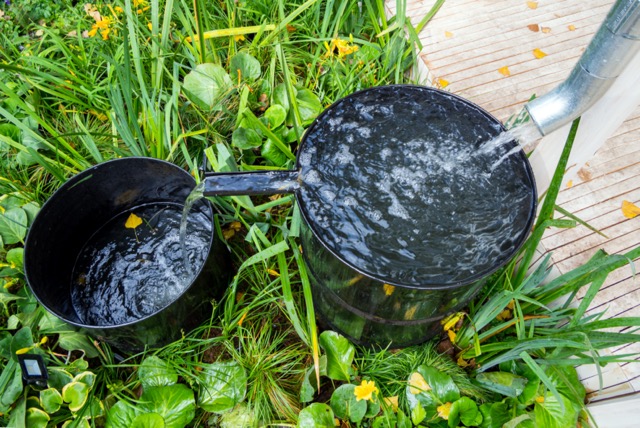This blog focuses on three drought-tolerant landscaping options for a gorgeous yard with minimal water usage. Maintaining a lush and vibrant landscape during hot, dry months can be challenging, especially when faced with water restrictions and drought conditions. However, Legit Landscapes can help you implement the right strategies to help keep your landscaping alive and thriving while conserving water.
Drought-Tolerant Landscaping Option 1: Drip Irrigation


One of the most effective ways to maintain a healthy landscape during water restrictions and drought is by implementing a drip irrigation system. Unlike traditional sprinklers that spray water into the air, drip irrigation delivers water directly to the roots of plants slowly and steadily. This targeted approach minimizes evaporation and runoff, ensuring that every drop counts.
Benefits of Drip Irrigation
- Water Conservation
- Drip irrigation systems can save up to 50% more water than conventional sprinklers.
- Reduced Weed Growth
- Drip irrigation reduces moisture on the soil surface by delivering water directly to plants, hindering weed growth.
- Disease Prevention
- Drip irrigation minimizes leaf wetness, which helps prevent the spread of fungal diseases.
- Customizable and Flexible
- Drip irrigation systems can be easily customized to suit different plant types and watering needs, ensuring optimal growth for each plant.
Drought-Tolerant Landscaping Option 2: Rain Barrels




Another excellent option to combat water restrictions and drought is using rain barrels. Rain barrels are large containers that collect and store rainwater from rooftops, allowing you to use this valuable resource for irrigation.
Rain barrels are typically made from durable materials such as plastic or metal. They feature a water inlet, a screen to prevent debris from entering, and a spigot for easy access to the stored water.
Benefits of Using Rain Barrels
- Water Conservation
- Rain barrels allow you to harness and store rainwater, reducing reliance on municipal water sources.
- Cost Savings
- By using rainwater, you can significantly reduce your water bill.
- Environmental Benefits
- Rain barrels help prevent stormwater runoff, which can carry pollutants and contribute to water pollution.
- Healthier Plants
- Rainwater is naturally soft and free from chlorine, providing plants with the ideal water source for growth.
Drought-Tolerant Landscaping Tool 3: Rainwater Tank/Rainwater Harvesting Tank




A rainwater tank, also known as a rainwater harvesting tank or water storage tank, is a container specifically designed to collect and store rainwater runoff from rooftops or other surfaces. These tanks can range in size and material, such as plastic, concrete, or metal, and are typically equipped with a gutter system or downspout to direct rainwater into the tank.
The Benefits of Rainwater Tanks
- Water Conservation
- Rainwater tanks allow you to collect and store rainwater, reducing the reliance on traditional water sources. This promotes water conservation, especially during periods of drought or water restrictions.
- Cost Savings
- By utilizing rainwater for non-potable uses, such as irrigation, you can reduce your water bill significantly.
- Reduced Strain on Municipal Systems
- When you rely on rainwater for non-potable uses, you lessen the burden on municipal water systems, helping to maintain the water supply during high-demand periods.
- Environmental Benefits
- Harvesting rainwater reduces stormwater runoff, which can carry pollutants and overwhelm drainage systems. By collecting rainwater, you contribute to mitigating local flooding and reducing water pollution.
How Rainwater Tanks Work

- Collection
- Rainwater is collected from rooftops or other surfaces by directing it through gutters and downspouts into the tank. Leaf guards or filters can be installed to prevent debris from entering the tank.
- Filtration
- Some rainwater tanks incorporate filtration systems to remove contaminants, such as leaves, twigs, or sediment, ensuring the stored water is cleaner and suitable for various uses.
- Storage
- The collected rainwater is stored in the tank until it is needed for specific purposes. The tanks are designed to be watertight, preventing leakage or contamination.
- Distribution
- Rainwater can be distributed from the tank through various means, such as gravity-fed outlets, pumps, or by connecting to irrigation systems. The distribution method depends on the intended use and the specific setup of the rainwater harvesting system.
Rainwater collected in rainwater tanks is generally unsuitable for drinking unless treated and filtered through additional purification systems. However, it is an excellent alternative water source for various non-potable applications, reducing the strain on freshwater resources.
By installing a rainwater tank, you can harness nature’s gift and utilize rainwater effectively, contributing to water conservation efforts and enjoying the benefits of reduced water bills and a more sustainable lifestyle.
Incorporating drip irrigation, rain barrels, and rainwater harvesting techniques into your landscaping practices can help you successfully navigate hot, dry months, water restrictions, and drought conditions. By implementing these three options, you can conserve water, reduce maintenance efforts, promote plant health, and create a visually appealing and sustainable outdoor space. Embrace these strategies and ensure your landscapes remain vibrant, even during water scarcity.
If you have questions about drip irrigation, rain barrels or rainwater tanks, or would like installation information, contact us. We would be happy to assist you with these water conservation techniques.

